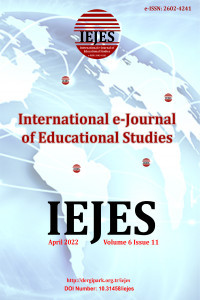Integration of Social Studies and English: Prospective Teachers’ Views “Feeding two birds with one scone?”
CLIL, ELT, social studies, teacher education
Integration of Social Studies and English: Prospective Teachers’ Views “Feeding two birds with one scone?”
CLIL, ELT, social studies, teacher education,
___
- Anderson, D. (2014). Outliers: Elementary teachers who actually teach social studies. The Social Studies, 105(2), 91-100. https://doi.org/10.1080/00377996.2013.850055
- Banegas, D. L. (2016). Teachers develop CLIL materials in Argentina: A workshop experience. Latin American Journal of Content & Language Integrated Learning, 9 (1), 17-36.
- Banegas, D. L. (2020). Teacher professional development in language-driven CLIL: A case study. Latin American Journal of Content & Language Integrated Learning, 12(2), 242-264.
- Barton, K. C., & Levstik, L. S. (2004). Teaching history for the common good. Mahwah, NJ: Lawrence Erlbaum Associates, Inc.
- Coşkun, A. (2022). Content and language integrated learning from the perspectives of English language teachers. Bartın University Journal of Faculty of Education, 11(2), 418–431. https://doi.org/10.14686/buefad.1068230
- Coyle, D., Hood, P., & Marsh, D. (2010). CLIL: Content and language integrated learning. Cambridge: Cambridge University Press.
- Dallinger, S., Jonkmann, K., Hollm, J., & Fiege, C. (2016). The effect of content and language integrated learning on students' English and history competencies–Killing two birds with one stone? Learning and Instruction, 41, 23-31.
- DelliCarpini, M. (2021). Developing the C in content and language ıntegrated learning: teacher preparation that builds learners’ content knowledge and academic language through teacher collaboration and integrated pedagogical training. In C. Hemmi & D. L. Banegas (Eds.), International perspectives on CLIL (pp. 217-237). Palgrave Macmillan.
- Eisner, E. (1992). Educational reform and the ecol-ogy of schooling. Teachers College Record, 93, 610–627. Gass, S., & Mackey, A. (2007). Input, interaction, and output in second language acquisition. In B. VanPatten, & J. Williams (Eds.), Theories in second language acquisition (pp. 175-199). Mahwah/NJ: Erlbaum.
- Gierlinger, E. (2007). Modular CLIL in lower secondary education: Some insights from a research project in Austria. In C. Dalton-Puffer & U. Smit (Eds.), Empirical perspectives on classroom discourse (pp. 79-118). Peter Lang.
- Goodlad, J. I., & Su, Z. (1992). Organization of the curriculum. In Philip W. Jackson (Ed.), Handbook of research on curriculum, (pp. 327-344). MacMillan.
- Goris, J. A., Denessen, E. J. P. G., & Verhoeven, L. T. W. (2019). Effects of content and language integrated learning in Europe A systematic review of longitudinal experimental studies. European Educational Research Journal, 18 (6), 675-698.
- Hacieminoglu, E. (2014).How in-service science teachers integrate history and nature of science in elementary science courses. Educational Sciences: Theory and Practice, 14 (1), 353–372, http:// doi.org/10.12738/estp.2014.1.1979.
- Holloway, J., & Chiodo, J.(2009). Social studies I.S. being taught t in elementary school: A contrarian view. Journal of Social Studies Research, 33(2), 235–261.
- Kassymov, G., & Çiftçi, H. (2020). The effect of CLIL training on Turkish EFL pre-service teachers’ self-efficacy beliefs and attitudes towards CLIL. English Langauge Education Publishing.
- Kinniburgh, L. H., & Busby, R. S. (2008). No social studies left behind: Integrating social studies during the elementary literacy block. Journal of Content Area Reading, 7(1), 55-85.
- Krashen, S. D. (1985). The input hypothesis: Issues and implications. Addison-Wesley Longman Limited.
- Mathis, P.B., & Boyd, N.C. (2009).Who is teaching social studies? Pre-service teachers' reactions. Social Science Research Practice, 4(3), 76-85
- Moore, P. & Lorenzo, F. (2007). Adapting authentic materials for CLIL classrooms: An empirical study. Vienna English Working Papers, 16(3), 28-35.
- Özbaş, B. Ç., & Güryay, B. (2014). Can social studies and language lessons be integrated via global education? English language teacher candidates’ perceptions. Procedia-Social and Behavioral Sciences, 116, 1132-1136.
- Perez-Canado, M. (2012). CLIL research in Europe: Past, present, and future. International Journal of Bilingual Education and Bilingualism, 15, 315-341.
- Başlangıç: 2017
- Yayıncı: Tamer KUTLUCA
Secondary School Students’ Attitudes and Teacher-Student Views on Questioning in Mathematics Course
Eyüp SEVİMLİ, Emin AYDIN, Ahmet Şükrü ÖZDEMİR, Gökhan DERİN
The Study of Thesis Made on Lifelong Learning in Turkey by Document Analysis
Rümeysa TUNA-GÜNDOĞDU, Aysel ARSLAN
Ethical Problems and Dilemmas Experienced by Preschool Teachers during the COVID-19 Epidemic
Ika YATRI, Endry BOERISWATI, Totok BINTORO
An Education Faculty Example in the Evaluation of the Distance Education Process: SWOT Analysis
Meral ÇELİKOĞLU, Hacı Mehmet YEŞİLTAŞ, Erol TAŞ
A Group Counseling Practice for Improving Middle-School Students’ Self-Esteem
Identity (Re)Construction of Turkish Pre-service Language Teachers during the Practicum
Collaborative Testing as an Alternative Assessment Technique in Algebra Education
